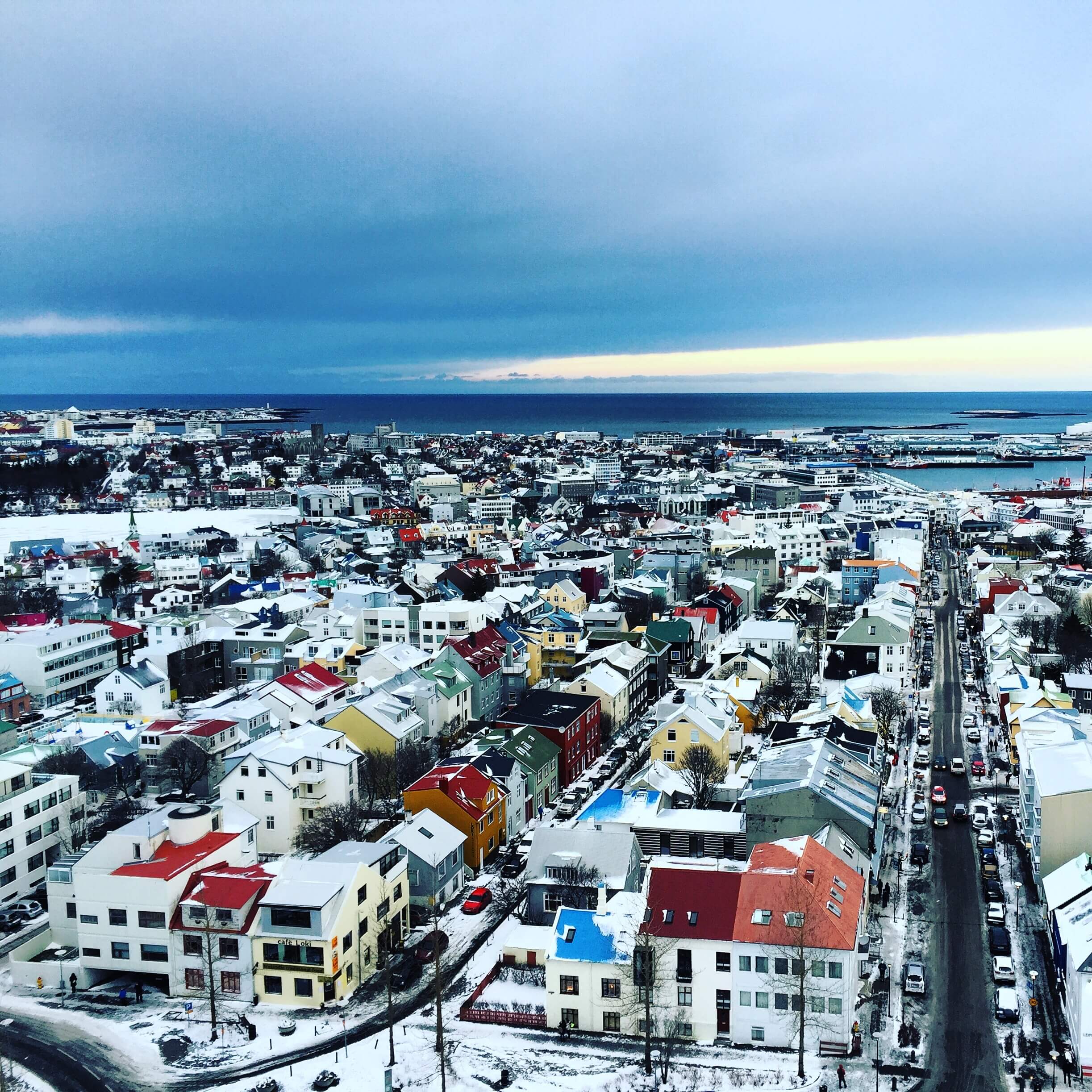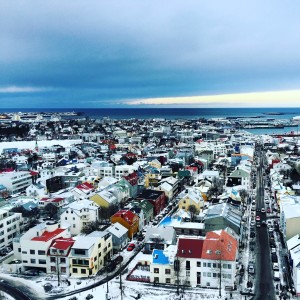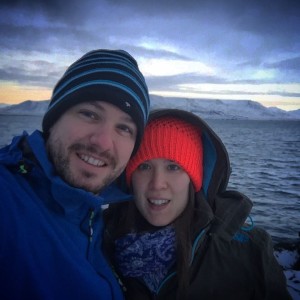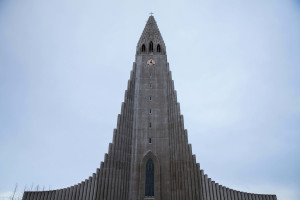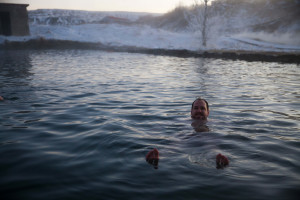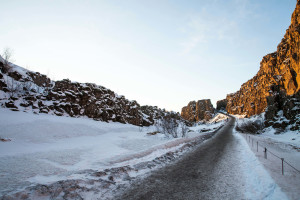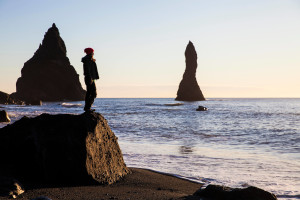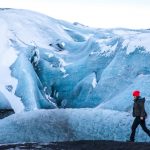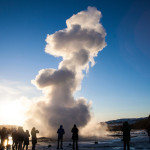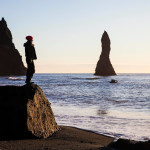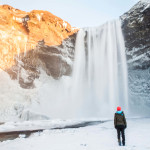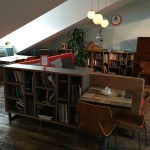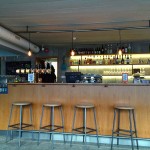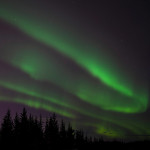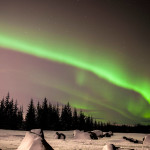Iceland is such an incredible country it is hard to know where to start. I spent four days exploring and can safely say that it is a good amount of time to fit in a lot of adventures. For the Northern Lights, January to March is a good time to go. Although be prepared for an arctic chill plus only a few hours of daylight. I visited in January, sunrise was at 11am and sunset around 4pm. It is strange adjusting to very dark mornings. The opposite can be said for the summer in Iceland, the daylight hours go the complete opposite way with the midnight sun making an appearance. This means pretty much twenty-four hours of daylight and warmer weather.
If you are planning a trip to Iceland here is my four-day itinerary…
From the airport Flybus operate services to Reykjavík in conjunction with all arriving and departing flights. Bus services go via the BSI bus terminal, and onto Reykjavík. (Pay for Flybus Plus to be dropped right outside your accommodation.) The journey takes about 45 minutes, pre book before you go or pay at the airport. It was a really fluid service plus there is WIFI on the buses.
You might be interested to know that the restaurant at the bus terminal sells not only burgers but also sheep heads. A traditional Icelandic dish which dates back to a time when people made use of every part of the animal. Not one I tried while I was out there, but very interesting to learn about Iceland’s culture.
Day 1
We stayed in the centre of Reykjavík at Loft Hostel, located on one of the main streets it was perfect and in walking distance of shops, restaurants, funky bars and the city’s main attractions.
A visit to Hallgrimskirkja church is a must; the impressive concrete structure was designed to look like volcanic basalt. Inside it houses an organ with 5727 pipes. For a small fee take the lift 74.5 metres to the top for beautiful panoramic views of Iceland.
If you are visiting in winter you will definitely need to warm up. Icelanders are into coffee in a big way so there are plenty of coffee shops dotted around to escape in from the cold. My favourite was Kaffi Brennslan, they had a delicious chocolate cake. Most of the coffee shops turn into restaurants and bars at night too with a quirky little place on most corners to choose from.
After you’ve warmed up take a stroll to the harbour. The famous Sun Voyager statue is a worth a look at and the mountainous backdrop is stunning.
If you are hoping to see the northern lights book a trip early on in your stay, that way you can increase your chances of seeing them. Many tour companies offer a free trip if you don’t spot them the first time around. Use Icelandic Met Office to check the Aurora forecast. On our first full evening there we went on a Northern lights hunt with Iceland Travel. With clear skies and a dark night we were very lucky to see the Aurora Borealis dancing and gliding in the dark sky. A super jeep tour meant a smaller group and we could go where coaches couldn’t, boy did those Land Rovers plough through the snow! After an awesome evening we even got see the lights again from the roof terrace of the hostel shining brightly above Reykjavík. For tips on capturing the Northern Lights on camera head here: Northern Lights Photography Tips.
Day 2
You can’t come to Iceland without seeing the Golden Circle. Matt and I decided to go on an organized tour, we had initially thought about hiring a car but were pleased we didn’t as due to a lot of snow the road conditions were pretty harsh and the Icelanders definitely have the skills to drive on their roads!
We chose a small group tour with Sterna Travel, the first stop was Þingvellir national park the sight of Iceland’s Viking parliament; here you can walk between shifting tectonic plates. Next up was the Geysir hot spring area; hot steam rises from bubbling geothermal water, and the famous geyser Strokkur is here. Pushing out hot plumes of water every few minutes it is very exciting and addictive to watch. The thundering falls of Gullfoss was one of my favourite stops of the day; this icy beauty was definitely worth getting cold for. As well as stopping at the main sights the tour also included a visit to a geothermal pool, Gamla Lagoon. As I’m pregnant I didn’t get to go in but Matt thoroughly enjoyed the 40°c dip with a beer for company!
For dinner we chose Islenski Barinn, a cosy restaurant with a quirky interior. I had halibut which was delicious. They had some interesting specialties on the menu, the Icelandic people like some weird stuff! Fermented shark, puffin and minke whale. We didn’t try any of these, as we weren’t sure if they were just a tourist fad. For dessert we had Skyr, an Icelandic speciality and very similar to Greek yogurt.
Day 3
We were up early for an adventure to the south coast, again with Sterna Travel. I was so excited to see Eyjafjallajökull, the volcano that erupted in 2010 cancelling over 100,000 flights all over the world. Next was the mighty Skógafoss one of Iceland’s biggest waterfalls, it has a 200ft drop and legend has it that there is buried treasure in the cave behind, unfortunately it was too cold that day for me to find out! We stopped for lunch at Reynisfjara beach near Vik. Black sand and basalt sea stacks make this a striking place for photos. My favourite stop on this trip was at Mýrdalsjökull, the most beautiful glacier. Having time to explore the base of this gigantic beauty was awe-inspiring. Deep blues and thickly patterned ice, topped off with snow-covered mountains high above, it was an epic spot. The last stop of the day was Seljalandsfoss waterfall, you can walk behind it, but it was so cold the staircase leading to the path was completely encased in ice. I was more than happy to just admire it from the front anyway!
We rounded up the evening back in Reykjavík with a very tasty lamb stew. Iceland is well-known for its lamb so it only seemed right to warm up with this dish after a very chilly but awesome day.
Day 4
Our final morning was spent relaxing over a leisurely breakfast after two busy days of sightseeing followed by souvenir shopping. A Lopapeysa or Icelandic sweater made with Icelandic sheep wool is the thing to buy here. However, at £100 – £150 they were way out of my budget. I did however stumble across some very cool vintage charity shops on Laugavuger, the main shopping street. Inside I found a few jumpers for £30, sadly they didn’t fit! This was followed by more coffee drinking and cake munching to keep warm. You can buy all sorts of weird and wonderful souvenirs; my favourite ones were glass tea light holders with volcanic ash from Eyjafjallajökull and lava rock ornaments. I did go into a Christmas shop and buy a Christmas decoration, as if you saw my blog back in December on all things Christmassy you will know that I love collecting decorations from my travels. A little Icelandic elf, I thought it would be a great reminder of our trip.
I loved everything about Iceland, it has such a trendy, cool vibe, the locals are super friendly and I even loved the cold. For me it added to the whole experience. My one tip would be to pack a lot of thermals and layers if you go during the winter, you will definitely need them.

